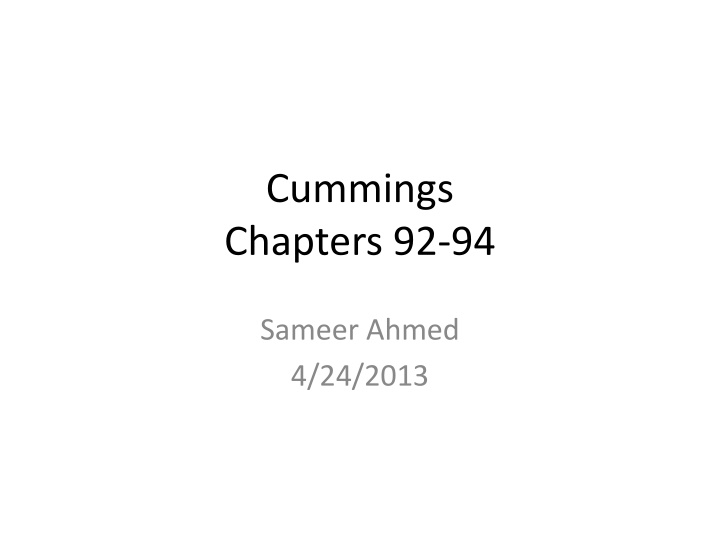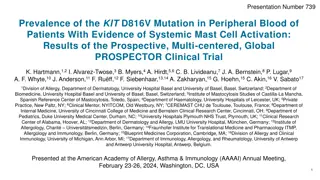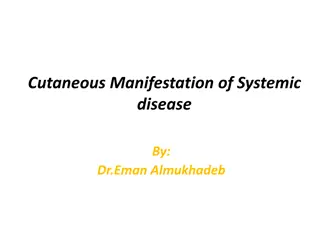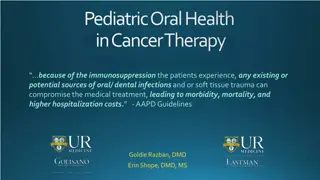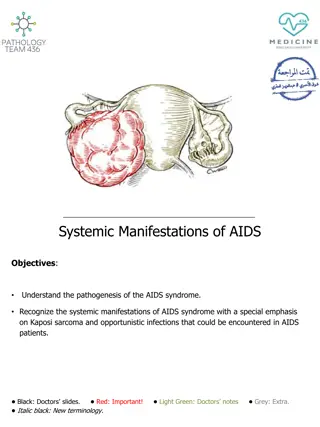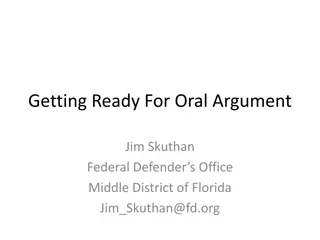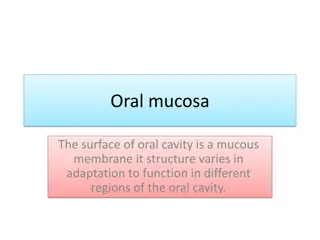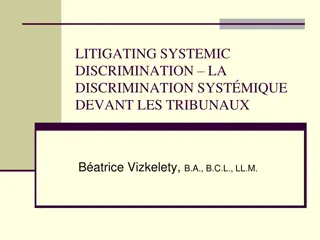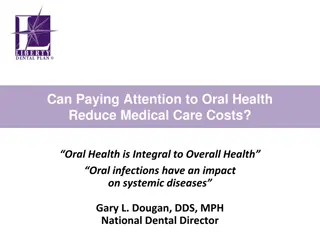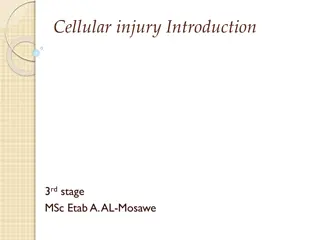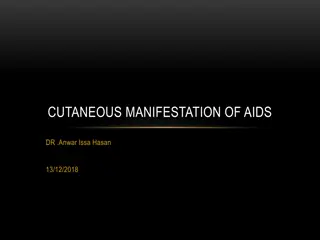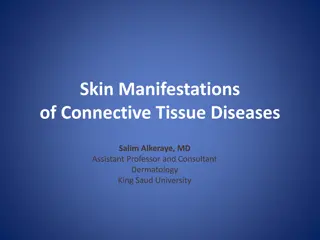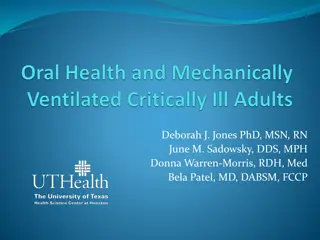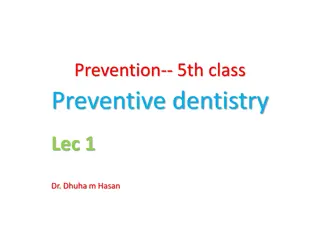Oral Manifestations of Systemic Diseases in Dentistry
This content explores various systemic diseases and their oral manifestations relevant to dentistry. It covers associations between heart disease and periodontal disease, effects of chronic corticosteroid use on the pulmonary system, endocrine disorders like diabetes and thyroid issues, autoimmune diseases such as Sjogren's Syndrome and systemic lupus erythematosus (SLE), highlighting the importance of recognizing these oral signs in clinical practice.
Download Presentation

Please find below an Image/Link to download the presentation.
The content on the website is provided AS IS for your information and personal use only. It may not be sold, licensed, or shared on other websites without obtaining consent from the author.If you encounter any issues during the download, it is possible that the publisher has removed the file from their server.
You are allowed to download the files provided on this website for personal or commercial use, subject to the condition that they are used lawfully. All files are the property of their respective owners.
The content on the website is provided AS IS for your information and personal use only. It may not be sold, licensed, or shared on other websites without obtaining consent from the author.
E N D
Presentation Transcript
Cummings Chapters 92-94 Sameer Ahmed 4/24/2013
Ch 92: Oral Manifestations of Systemic Diseases
Cardiac Association between heart disease and periodontal disease Calcium channel blockers gingival enlargement Disturbance in taste ACE, Ca Channel blockers Cyclosporine gingival enlargement
Pulmonary Chronic use of corticosteroids suppresses hypothalamic-pituitary-adrenal axis Result in acute adrenal insufficiency during stress Therefore steroid replacement therapy is sometimes required for extensive dental and surgical procedures The classic oral mucosal lesion of TB is a painful, deep, irregular ulcer on the dorsum of the tongue
Endocrine Diabetes Association between severe periodontitis and an increased risk of poor glycemic control. Adrenal Addison's disease, caused by primary adrenal insufficiency or hypoadrenalism, include diffuse, cutaneous pigmentation of the skin and mucous membranes With hyperadrenalism or Cushing's disease, present with moon shaped face and muscle weakness
Endocrine Thyroid Macroglossia is the primary oral manifestation of hypothyroidism Parathyroid Hyper PTH: Bone demineralization from excessive osteoclast function (indirect effect of PTH, RANKL) Subsequent fibrous-tissue replacement can produce well- defined cystic radiographic radiolucencies (Brown tumor)
Autoimmune Sjogren's Primary SS salivary and lacrimal gland disorders Secondary SS the disorder occurs with other autoimmune diseases such as RA Focal, periductal, mononuclear cell infiltrates (mainly T cells) in exocrine tissues and autoantibodies (particularly anti-Ro/SSA, anti- La/SSB, and rheumatoid factor) 44-fold increase in B-cell lymphoma risk
Autoimmune SLE Approximately one quarter of SLE patients have oral lesions Usually superficial ulcers with surrounding erythema Dermatomyositis/Polymositis Can involve tongue and UPPER esophagus (upper third, involving UES)
Bacteria Porphyromonas gingivalis and Treponema denticola periodontal disease Staphylococcus aureus and Streptococcus viridans salivary gland infections Streptococcus mutans and Lactobacillus sp new and recurrent dental caries.
Syphillis Congenital syphilis Hutchinson's incisors (notched incisors) Mulberry molars (multiple rounded rudimentary enamel cusps on the permanent first molars).
Lichen Planus Lichen planus is a chronic, mucocutaneous, autoimmune disorder Some evidence suggests that lichen planus lesions are predisposed to malignant transformation
Pemphigus Vulgaris Pemphigus vulgaris is an autoimmune disease caused by antibodies created against desmoglein 3 Disassociation of the epithelium at the suprabasal layer with acantholysis +Nikolsky's sign
Vitamin Deficiencies Vitamins A and B2 (riboflavin) angular chelitis Vitamin B12 aphthous ulcer, angular chelitis, loss of tongue papillae Niacin swollen tongue, pellagra
Neurologic In myotonic muscular dystrophy, why does the tongue get large? Enlargement of the tongue caused by fatty deposits.
Renal Heparin is administered during dialysis to prevent blood coagulation dental procedures should be performed on alternate days of dialysis
Liver Oral microbial infections and impaired wound healing Most common oral complications of patients with cirrhosis Result of alcohol-induced immunosuppression
Heme Von Willebrand's disease Most common hereditary bleeding disorder Deficiency of secondary factor VIII (vWF) Resulting in poor platelet adhesion Wiskott-Aldrich syndrome X-linked recessive inherited disease, Recurrent infections, eczema, and chronic thrombocytopenia (in OC mucosa, manifests with petechiae and ecchymoses)
Inherited Disorders Cowden's disease Autosomal dominant Warty/hamartomatous papules on the face, arms, and mucous membrane of the mouth Melkersson-Rosenthal syndrome Unilateral facial paralysis Edema of the periorbital skin Fissured tongue with papillary projections
Ch 93: Odontogenesis, Odontogenic Cysts, and Odontogenic Tumors
Background Odontogenic tumors: mix of epithelium and mesenchyme, hard to analyze histologically All odontogenic tumors/cysts related to the stomodeum in some way.
Embryology The stomodeum: depression between the brain and the pericardium in an embryo, and is the precursor of the mouth and the anterior lobe of the pituitary gland.
Epithelial Odontogenesis The four main stages of epithelial odontegenesis are (1) dental lamina, (2) enamel organ, (3) reduced enamel epithelium, and (4) Hertwig's epithelial root sheath.
The enamel organ is generally divided into the bud stage, cap stage, and bell stage. Epithelial bands dental lamina > 20 tooth buds Reduced enamel epithelium Consists of inner enamel epithelium (ameloblast cells) and outer enamel epithelium (cuboidal cells from dental lamina). As the cells of the reduced enamel epithelium degenerate, the tooth is revealed progressively with its eruption into the mouth.
Hertwig's rooth sheath: a layer of cells that separate away from the reduced enamel epithelium, as they move towards the tooth root. On their way, they leave behind rests of Malassez small islands of epithelial tissue that are formed during tooth root development, they are located in the region of the periodontal ligament
Cysts Periapical/Radicular cyst The periapical cyst must be associated with a nonvital tooth, located at the tooth apex. Tx: Most of these cysts adequately resolved with endodontic therapy. If a radiolucency persists longer than 6 months following endodontic therapy, enucleation and histopathologic review are necessary.[
Cysts Dentigerous cysts Form when fluid accumulates between reduced enamel epithelium and tooth crown of an unerupted tooth (near the cementoenamel junction) . Usually occurs in impacted teeth (3rd molars, maxillary canines) Some malignant potential (SCCa, mucoep, ameloblastoma) Tx: Dentigerous cysts are usually easily enucleated at the time of tooth extraction.
Cysts Lateral Periodntal Cyst: unilocular cyst, from dental lamina, on the lateral surface of a vital tooth Tx: enucleation Botryoid Odontogenic Cyst: multilocular cyst, from dental lamina, on the lateral surface of a vital tooth Tx: enucleation + curettage
Keratinizing odontegenic cyst is NOT the same as an odontegenic keratocyst (OKC, more recently named as an keratocystic odontogenic tumor)
Cysts OKC OKCs are most common in the mandibular third molar area, but can be in the maxilla or mandible 2nd to 3rd decade most common age group swelling, pain, trismus, sensory deficits, and infection being the most common complaints But can be an incidental finding on xray also Unilocular vs multilocular; multiple vs single cysts With multiple cysts, think about working up basal cell nevus syndrome
OKC Tx: Debatabe. Author says dont use aggressive approach on everyone (e.g.: for large lesions, try decompression and then curettage as opposed to excision and tooth extraction). 1st occurrence: excise the entire lesion, especially the inner cyst lining, limited bone curettage Recurrences: be more aggressive (except in basal cell nevus syndrome patients as recurrences are probably new lesions)
Cysts Calcifying Odontogenic Cyst It can fall into 2 categories: cystic or neoplastic Cystic from early dental lamina, anterior mandible most common. On path ghost cells seen (but not pathognomonic). Tx: enucleation for simple, unilocular; enculeation and curettage for multilocular Neoplastic; ghost cell tumor The epithelial odontogenic ghost cell tumor is an unusual jaw lesion that consists of solid, tumor-like mass, though a cystic area is usually present as well.
Malignant transformation of cysts it's rare but can happen in any cyst (when we do hear about it, it's usually a dentigerous cyst or OKC). Often happen in residual cysts left in an edentulous area.
Odontogenic Tumors Ameloblastoma (intraosseus, solid, multicystic) Neoplasm of enamel; comes from the lining of odontegenic cyst, reduced enamel epithelium, or odontogenic rests of tissue. 80% in the mandible Radiology: soap bubble or honeycomb appearance Path: histologic subtypes include follicular, plexiform, granular cell, acanthomatous, desmoplastic, basal cell, and keratinizing Tx: at least 1 cm margins in mandible (proximal and distal directions), 1-2 cm margins in maxilla However, Tx not well defined (enuclation alone is def not a good option)
Odontogenic Tumors Unicystic ameloblastoma Posterior mandible most common Asymptomatic Radiology: Single radioloucent, unilocular, well- demarcated lesion, <2cm No extension into connective tissue (no plexiform or follicular variants) Tx: enucleation only; generally no recurrence
Odontogenic Tumors Peripheral Amelobastoma (Extraosseus) Peripheral ameloblastomas present as mucosal masses and arise from the gingiva or alveolar mucosa. If any bone is involved, it is not a peripheral amelobastoma Tx: excision; generally no recurrence
Malignant Ameloblastomas Benign histopathologic features of amelobastoma but metastasize to distant locations Lung is most common Ameloblastic Carcinoma Cytopathologic features associated with malginangy; +/- metastasize
Ameloblastic Fibroma Benign odontogenic neoplasm characterized by proliferation of immature mesenchymal and ameloblastic cells (found in developing teeth) Posterior mandible Well-defined radiolucency Tx: Unilocular conservative enucleation; Multilocular > segmental rsxn if jaw integrity is messed up
Calcifying Epithelial Odontogenic Tumor (Pindborg Tumor) Mandible > Maxilla Molar and pre-molar region Well-circumscribed, multilocular > unilocular, mixed radiolucent-radiopaque Tx: conservative surgical removal (usually enucleation and curettage) However, tumors with clear cell changes may be more aggressive Segmental rsxn reserved for those tumors which have messed up the jaw already
Adenomatoid Odontogenic Tumor Most innocuous odontogenic tumor Comes from the enamel or from the dental lamina 2/3 female, 2/3 in maxilla Mixed radiolucent-radiopaque Tx: Enucleation, low recurrence rate
Temporomandibular disorders: Intracapsular disorders, or true abnormalities of the temporomandibular joint (TMJ), and muscular disorders, or myofascial pain Symptoms: facial pain, earache, and headache.
Anatomy TMJ Synovial joint Articulating surfaces: glenoid fossa and condylar process Articular disk is between these 2 surfaces Articular disk separates the joint space into 2 compartments The inferior compartment: anterior and posterior rotational The superior compartment: translational movement between the disk and the glenoid fossa
Fractures Condylar or subcondylar fractures preauricular pain and tenderness, difficulty in opening the mouth, and malocclusion Unilateral fracturejaw deviation to the affected side on attempted mouth opening Bilateral fractures frequently produce an anterior open (loss of support in ascending ramus)
Dislocation Acute dislocation Condyle translates anterior to the articular eminence and becomes locked in that position. Tx: apply downward pressure on the posterior mandible while placing upward and backward pressure on the chin. Restrict mandibular opening for 2 to 4 weeks NSAIDs
Dislocation Chronic Dislocation Tx: inject sclerosing agent into the TMJ capsule to produce scarring of the stretched tissues
Neoplasms Rare to have tumor originating in TMJ Often, these tumors are not radiosensitive so you need to operate
Intracapsular Disorders 1. Anterior disk displacement with reduction Mouth opening Clicking, popping sound Normal range of mandibular motion Treatment of these painful joints consists of soft diet, self-limitation of opening, NSAIDS, splint therapy, and physical therapy
